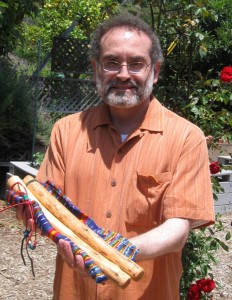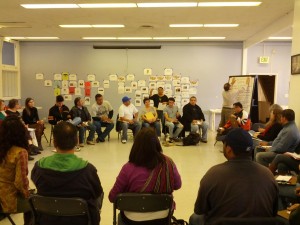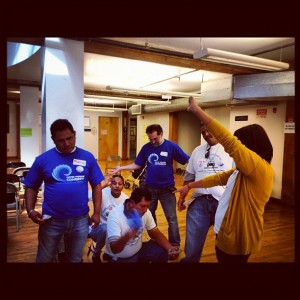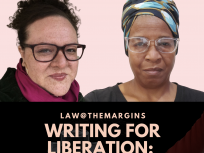
With the continuing assault on the labor movement by right wing forces and corporate America, public sector labor unions that represent government are now facing a series of challenges, not least of which is the blame for pushing up the pension and other costs that state and local governments contend they can no longer afford — as in Detroit’s $18 billion bankruptcy. They also see a high-profile presidential candidate — Wisconsin Governor Scott Walker — basing much of his campaign on the pride of having beaten down public sector unions in his home state. But their biggest challenge right now may lie in the Supreme Court, where the Justices are to take up the case of Friedrichs v. California Teachers Association that will have a major impact on public sector unions. Similarly with the immigrant rights movement, the inability to accomplish Comprehensive Immigration Reform has placed us at a difficult crossroads of how to proceed and what new strategies to develop. Adding to that situation is the ugliness of the most recent immigration debate and the hateful rhetoric from Donald Trump and extreme right factions.
In the past two years, I have embarked on an activist journey of sharing with the immigrant rights and labor movements my prescription and insights on the importance of a spiritual framework on how we approach the work for justice, how we treat one another in the struggle, and how we remain truly accountable to the communities we are trying to help. I have written on this topic on Law@theMargins before in the context of the immigrant rights and labor movement. In 2014, I wrote about advocates committing “malpractice” on the immigrant communities impacted by our strategy decisions, just as lawyers commit malpractice when they fail to exercise due diligence or are grossly negligent in the representation of their clients. The fight for humane immigration reform calls upon us to step back, reflect, and assess our strategies to create a more just and humane society for millions of immigrant families. If managed well, our next steps in this critical moment could bring greater solidarity away from a sometimes-fractious movement. Similarly, I called for a new approach to moving forward in confronting the major threats facing the labor movement today with a particular focus on self-care and community-care within the labor movement.
The spiritual framework of my activism comes from two major inspirations: St. Francis of Assisi, and Thich Nhat Hanh, Vietnamese Buddhist Zen Master, poet, scholar, and human rights activist whose thinkings serve as a foundation to my book, Living Peace: Connecting Your Spirituality with Your Work for Justice. Embedded in the work of social justice activism are values that we find in different spiritual faiths like compassion for others, and I encourage social justice activists to practice them in their daily work. In a recent training, geared towards activists, I provide some concrete tools to incorporate those values into our daily social justice work which I share below. These tools are guided by two core principles: (1) loving speech and active listening, and (2) leadership through humility, which I discuss at length in my book, and in an earlier post titled, Employing a Spiritual Framework to Advance the Immigrant Rights Movement. As activists, it is important to share different tools and methodologies to strengthen our activism and the movement. Whether it is silent meditation, praying, group reflection, or other reflective practices, we must share and learn from one another to the social justice movement. Lawyers and legal educators have also recognized the value of reflection in the profession through courses and groups on contemplative lawyering. The following are effective tools and processes that I have learned over the years from great mentors to facilitate and implement the two overarching principles above. These tools are readily accessible and simple to apply no matter what your work entails – policy, legal, organizing and leadership development.

Talking Stick
The talking stick dates back to indigenous communities in North America before Columbus. The chief or elder of the tribe would hold the stick to signify the start of the meeting. He would make his statement and then hold the talking stick out to his tribe. Anyone who felt that they had something to offer to the conversation would take their turn with the talking stick and state their thoughts or opinions. Only the person that was holding the stick was allowed to speak unless they were given permission by the person that was holding it. The rule of speaking only when you had the stick was respected and the members of the tribe adhered to the rules for its use. Much respect was given to the talking stick. The Great Spirit Creator was said to listen carefully to what was being said and thought as the tribe member or chief held the stick.
A growing number of people recognize the talking stick as a powerful tool for facilitating meaningful conversation. To fully actualize the power of this medicine tool involves recognizing, communicating and engaging its full potential for encouraging individual growth, meaningful conversation, and group healing. The power of the talking stems from its history and the authority we bestow upon it. Its history includes countless cultures and communities over many generations who granted meaning to such items as a stick, staff, feather or other artifact, and said we will use it to engage in meaningful group planning or problem-solving. The talking stick also has a contemporary history in which activists, counselors, educators, human resource managers and others have been using it to facilitate authentic and meaningful conversations. I have used talking stick to engage in meaningful group planning, problem-solving, or conflict resolution.
Walking Meditation
In our work for justice, we are always walking somewhere – to a delegation or legislative visit, to a meeting, or through a neighborhood to do house visits. Walking meditation is a form of meditation in action where we use the experience of walking as our focus. We become mindful of our experience while walking, and try to keep our awareness involved every step that we take. This is a great way for us to re-center or re-ground ourselves, especially when we find ourselves in a highly stressful situation. The practice of walking meditation can fit in to the gaps in our lives quite easily. Even walking from the car into the supermarket can be an opportunity for a minute’s walking meditation. The best way to learn this practice is to be led through it. One simply takes one’s awareness through one’s experience while walking. But in other ways it’s more complex — simply because there is a lot you can be aware of while doing walking meditation.

Unity Reflection Circle
The circle is an ancient, primal symbol. To Native Americans, the symbol represents something that is sacred and holy. A unity circle is a powerful tool for meaningful spiritual reflection, dialogue, and communication to enhance deep solidarity. Unity circles are great within any gathering to engage in a joyful, spiritual and inspiring process to develop a strong connection and unity among participants. They also provide a special space for participants to commit or re-commit themselves to a struggle or campaign that they are involved with to improve their community. The circle can create a synergistic environment where people feel more connected and are better able to share and listen. Learning how to create these circles and facilitate can provide you with an invaluable tool for any group effort.
The process begins with the person creating the circle, or “circle maker.” Anyone can be a circle maker. All you need is the dedication and commitment to bringing people together to speak and listen from their hearts for purposes of creating a moment for growth, gratefulness and inspiration. Knowledge of the historical significance of unity circles aids in helping others in the group understand the importance and sacredness of the circle that they are about to engage in. The basic steps in the process of creating and forming the circle are 1) forming the circle; 2) welcoming everyone into the circle; 3) sharing an introduction – it can be a prayer, reflection or historical significance of the moment; 4) inviting the dialogue that encourages speaking and listening from the heart; and 5) closing the circle with words that captured the sacredness of the special moment. After the circle, you should always invite for hugs and other acts of solidarity.
“Conociemento” or Co-Powerment Process
Roberto Vargas, my mentor and spiritual guide over the years, creates the concept of “Conocimiento” in his book, Family Activism: Empowering Your Community, Beginning with Family and Friends. Co-powering is a concept that comes from the Latino community speaking to the responsibility for individual leaders to mindfully work toward supporting the personal power of others through modeling, validating, and feedback. It is a process of developing our skills to empower each other. We engage in co-powerment communication to consciously confront the negativity that undermines our personal, family and community relationships. A true co-powerment process reaches the state of what is known as “conocimiento.” There is no English translation for this term, but it basically means “sharing knowledge about each other to know each other.” Too often in our activist work, we put task before relationship. In fact, it needs to be the other way around. Always attend to relationships before starting the task. As an activist for justice, you have a great potential to help others achieve co-powerment and shared knowledge so that they can become activist leaders in their struggles. Achievement of “conocimiento” in any relationship creates the foundation for 1) courageous conversations, and 2) giving and receiving praises.

Courageous Conversations
A true co-powering relationship establishes the space for us to be able to address conflicts and other tough issues through courageous conversations. Working in coalition or a team on a major campaign is a beautiful coming together of a diversity of personalities, experiences, backgrounds and other attributes. This is a human element of our work for justice that we must embrace and cherish. Our diversity is our strength. In order to be effective in our campaigns and other efforts for justice, we must sometimes be held accountable and hold others accountable for their actions, behavior, quality of their work, etc. Let’s face it: doing this is not comfortable. At some point, we will find ourselves needing to have a difficult conversation with a colleague, supervisor or ally partner. Luckily, there are many tools and resources available to help us build the skills to do this in a way that maintains (and even improves!) our relationships and moves us forward. The Rockwood Leadership Institute provides information and materials on this topic.
With courageous conversations, we are able to create an effective process of giving and receiving feedback where person giving feedback comes into the dialogue with a desire to help in the self-development of the person receiving the feedback. The person receiving and listening is then able to embrace the person providing the feedback in an open and honest way. Finally, this can be an effective tool for conflict resolution.
Giving and Receiving Praise
We don’t praise enough in the work for justice. We criticize more than we praise. This is very common in the immigrant rights and labor movements. It has created an unhealthy movement for all of us. When giving praise, we are capable of both under and over-doing it. The fear of appearing overeager might stifle the praise that we really want to give in our heart. We don’t want to make other people uncomfortable with unwanted attention, and yet this kind of attitude might discourage people who might be unsure of themselves. On the other side of a compliment, there is always a receiver. Think of what kind of compliments you would like to receive in your life as an activist, and think of ways to make others feel good by noticing those qualities in them! All this talk about giving compliments has to inevitably end up in a note on how to receive compliments and accept the praise of others. It is not a selfish act to receive praises when you have reached a great accomplishment in your activist work.
Storytelling
If we want to truly connect with our allies and to move people to action, we must tell our own stories. More importantly, however, is our willingness to create the space for community members impacted by the issues that we focus on in our work for justice. Through a process of storytelling, we co-power community members to become the leading voices for campaigns for immigration reform and worker justice. Storytelling enables us to step back and allow others to step up as leaders. Storytelling is also a powerful counterpoint to the “fact fog” we sometimes find ourselves in as activists, as well as to political rhetoric, which is sometimes so worn from repetition that our audiences tune us out.
In conclusion, as we struggle with the present failure of CIR and the dismal situation impacting many workers today, let us embrace a new approach to moving forward together. We have access to shared spaces and shared knowledge to learn from each other, co-power one another, and create true meaningful leadership within our communities. It requires courage and a willingness to take risks to foster and implement new strategies and directions, but we owe nothing less to the communities impacted by the injustices we fight against every day. It is time for us to engage in the work for justice with leadership through humility and compassion, and allow it to become a way for our hearts to connect and create true solidarity.
For more information on Victor’s book, Living Peace: Connecting Your Spirituality with Your Work for Justice, go to https://www.facebook.com/ConnectingSpirituality. He can also be found on Twitter at @narrovictor.





[…] following was written by alum Victor Narro, and originally posted at Law at the Margins. Victor’s book, Living Peace: Connecting Your Spirituality with Your Work for Justice, is […]